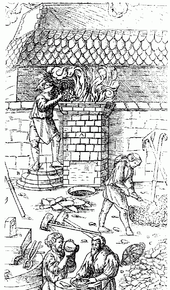
Back تعدين الحديد Arabic Qara metallurgiya Azerbaijani Ҡара металлургия Bashkir Чорная металургія Byelorussian Чорная мэталюргія BE-X-OLD লৌহঘটিত ধাতুবিদ্যা Bengali/Bangla Siderúrgia Catalan Jernfremstilling Danish Stahlindustrie German Siderurgio Esperanto

Ferrous metallurgy is the metallurgy of iron and its alloys. The earliest surviving prehistoric iron artifacts, from the 4th millennium BC in Egypt,[1] were made from meteoritic iron-nickel.[2] It is not known when or where the smelting of iron from ores began, but by the end of the 2nd millennium BC iron was being produced from iron ores in the region from Greece to India,[3][4][5][6][7][8][page needed] The use of wrought iron (worked iron) was known by the 1st millennium BC, and its spread defined the Iron Age. During the medieval period, smiths in Europe found a way of producing wrought iron from cast iron, in this context known as pig iron, using finery forges. All these processes required charcoal as fuel.
By the 4th century BC southern India had started exporting wootz steel, with a carbon content between pig iron and wrought iron, to ancient China, Africa, the Middle East, and Europe.[citation needed] Archaeological evidence of cast iron appears in 5th-century BC China.[9] New methods of producing it by carburizing bars of iron in the cementation process were devised in the 17th century. During the Industrial Revolution, new methods of producing bar iron by substituting coke for charcoal emerged, and these were later applied to produce steel, ushering in a new era of greatly increased use of iron and steel that some contemporaries described as a new "Iron Age".[10]
In the late 1850s Henry Bessemer invented a new steelmaking process which involved blowing air through molten pig-iron to burn off carbon, and so producing mild steel. This and other 19th-century and later steel-making processes have displaced wrought iron. Today, wrought iron is no longer produced on a commercial scale, having been displaced by the functionally equivalent mild or low-carbon steel.[11]: 145
- ^ Rehren, T. (2013). "5,000 years old Egyptian iron beads made from hammered meteoritic iron" (PDF). Journal of Archaeological Science. 40 (12): 4785–4792. doi:10.1016/j.jas.2013.06.002.
- ^ Cite error: The named reference
ephotoswas invoked but never defined (see the help page). - ^ Riederer, Josef; Wartke, Ralf-B.: "Iron", Cancik, Hubert; Schneider, Helmuth (eds.): Brill's New Pauly, Brill 2009
- ^ Early Antiquity By I.M. Drakonoff. 1991. University of Chicago Press. ISBN 0-226-14465-8. p. 372
- ^ Rao, Kp (2018). "Iron Age in South India: Telangana and Andhra Pradesh". In Uesugi, Akinori (ed.). Iron Age in South Asia. Research Group for South Asian Archaeology. ISBN 978-4-9909150-1-8. Retrieved 12 April 2022.
- ^ Miller, Duncan E.; van der Merwe, N.J. (1994). "Early Metal Working in Sub-Saharan Africa: A Review of Recent Research". Journal of African History. 35: 1–36. doi:10.1017/s0021853700025949. S2CID 162330270.
- ^ Stuiver, Minze; van der Merwe, N.J. (1968). "Radiocarbon Chronology of the Iron Age in Sub-Saharan Africa". Current Anthropology. 9: 54–58. doi:10.1086/200878. S2CID 145379030.
- ^ Waldbaum (1978).
- ^ Cite error: The named reference
Wagnerwas invoked but never defined (see the help page). - ^ Williams, David (1867), "The Iron Age [weekly journal]", Iron Age, New York: David Williams, ISSN 0021-1508, LCCN sc82008005, OCLC 5257259
- ^ Cite error: The named reference
Tylecotewas invoked but never defined (see the help page).
© MMXXIII Rich X Search. We shall prevail. All rights reserved. Rich X Search